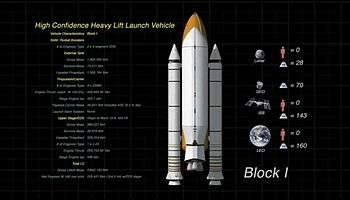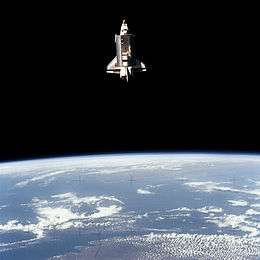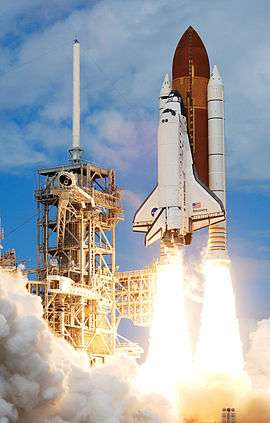Shuttle-Derived Heavy Lift Launch Vehicle
The Shuttle-Derived Heavy Lift Launch Vehicle, also known as the High Confidence Heavy Lift Launch Vehicle (or even variations of the "Side Mount Launch Vehicle" or "HLV" or "Not Shuttle-C") was an alternate launch vehicle proposal for the NASA Constellation program. It was first presented on June 17, 2009 by John Shannon, NASA's Shuttle Program manager, to the Augustine Commission which is tasked to review NASA's human spaceflight program.
It was based on the Shuttle-C concept which has been the subject of various studies since the 1980s. Derived from then currently used Space Shuttle hardware, i.e. an Shuttle-Derived Launch Vehicle (SDLV), it was proposed to replace the winged Orbiter from the Space Shuttle stack with a simple non-winged side-mounted payload carrier. The designs of the Space Shuttle's External Tank (ET) and the four-segment Shuttle Solid Rocket Boosters (SRBs) would have been reused.
According to NASA's John Shannon the HLV could have be developed within 4 1⁄2 years until the first manned flight occurs. The development program should have costed about US$6.6 billion,[1] which was only about 20% of the costs estimated for the Ares I and Ares V vehicle development.
Following President Obama 2010 space policy speech at Kennedy Space Center and the NASA Authorization Act of 2010 another HLV program, the Space Launch System, which is also Shuttle-derived, has been selected to replace the Constellation launch vehicles, with the development commencing thereafter.
Origin

An unmanned side-mounted concept of the Space Shuttle named Shuttle-C was the subject of various concepts that were investigated between 1984 and 1995.[2] After the Space Shuttle Columbia accident a two-year industry study was prepared in 2004 and 2005 to further investigate the concept in order to replace the Space Shuttle. The Exploration Systems Architecture Study (ESAS) in 2005 also investigated a Shuttle-C option for Project Constellation, however again only in an unmanned version. All these concepts included the side-mounted carrier to be an autonomous spacecraft which would detach from the External Tank after main engine cut-off similarly to the Space Shuttle. Some of the studies included the reuseability of the Space Shuttle Main Engines on this side-mounted carrier. None of the concepts involved in-ascent fairing separation.
The Shuttle-C concept as a cargo only option was not funded in the 1980s and 1990s due to NASA's budgetary constraints. The 2004–2005 industry study provided an updated proposal, which was looked at by ESAS but was ultimately deemed inferior to the Ares I and Ares V option. Crewed side-mounted Shuttle-C concepts were not looked at all in ESAS.
The HLV proposal presented by John Shannon on June 17, 2009 is partly based on the original Shuttle-C proposal but differs considerably from it, mainly due to not using the side-mounted carrier as a separate spacecraft which detaches from the ET and due to proposing to also carry crews on the HLV, not just cargo. The team involved in analysing and designing the HLV design at NASA include about 60 NASA engineers headed by Rick Manella.[3]
HLV specifications
The HLV was proposed to be a 4,600,000 pounds (2,100,000 kg) vehicle at liftoff with two 4-segment Space Shuttle Solid Rocket Boosters weighing about 2,600,000 pounds (1,200,000 kg) providing a total thrust of 5,900,000 pounds-force (26 MN) at sea level, with the Space Shuttle External Tank weighing about 1,660,000 pounds (750,000 kg) in a fuelled stage and a propulsion and payload carrier side-mounted to the vehicle.

This side-mounted carrier was to include a boattail carrying the propulsion elements which include 3 Space Shuttle Main Engines weighing about 57,000 pounds (26,000 kg) in total and the 7.5 meters (25 ft) diameter payload carrier with a separable fairing weighing 51,000 pounds (23,000 kg). The basic vehicle would not require an upper stage. Orbit circularization for missions to lower Earth orbit or trans-lunar injection burns for missions to the Moon or other destinations outside Earth orbit were to be provided by the payload which detaches from the HLV after the main ET fuel is depleted.[4]
The only completely new hardware development to be required for the HLV was the side-mounted carrier. All other components used on the HLV were previously in use with the Space Shuttle. According to John Shannon's proposal the first several flights (up to 6 flights) of the vehicle would have reused spare parts of the retired Space Shuttle fleet and salvaged functioning hardware from the orbiters, including existing avionics modules, the Flight Software and the Space Shuttle Main Engines (SSMEs) (Block I flights). Virtually no change to the existing Space Shuttle infrastructure, from the Vehicle Assembly Building to the External Tank barge to the launch pads was to be required.
Upper stage
Although technically not part of the HLV, the proposal envisioned that the upper stage which is attached to the payload and rests in the payload fairing for launch was to be a J-2X engine that was under development for the Ares I launch vehicle. It would have provided nearly 300,000 pounds-force (1.3 MN) (vacuum) and had a specific impulse (Isp) of 448 sec.
Alternatively The United Launch Alliance had proposed that their Dual Thrust Axis (Lunar) Lander (DTAL) could fit in a side mount payload shroud. The United Launch Alliance proposed ACE 41 and ACE 71 upper stage/fuel depot could have also fitted inside a side mount payload shroud and the ACE 71 at 75 metric tons (83 short tons) was well within the side mount shuttle derived vehicles payload capacity.[5] This would have eliminate the need for evolving the directly shuttle derived vehicle when combined with a fuel depots architecture.
Performance
The HLV's 4-segment SRBs were to deliver a specific impulse (Isp) of 267 sec and a thrust of 5,900,000 pounds-force (26 MN) and burn for about 155 seconds. The SSME main engines were to be flown at 104.5% and deliver a specific impulse (Isp) of 452 sec and 1,500,000 pounds-force (6.7 MN) (vacuum) and burn for about 500 seconds (depending on the mission profile). The payload mass for different missions was envisioned as follows:[6]
- Block I vehicle without an upper stage - 79 metric tons (174,000 lb) (gross) and 71 metric tons (157,000 lb) (net) to a 120 nautical miles (220 km) × 120 nautical miles (220 km) reference orbit (28.5°) from Kennedy Space Center
- Block II cargo vehicle with an upper stage (mass of upper stage not included) - 90 metric tons (200,000 lb) (gross) and 81 metric tons (179,000 lb) (net) to a 120 nautical miles (220 km) × 120 nautical miles (220 km) reference orbit (28.5°) from Kennedy Space Center
- Block II crew vehicle with an upper stage (mass of upper stage not included) - 92 metric tons (203,000 lb) (gross) and 83 metric tons (183,000 lb) (net) to a 120 nautical miles (220 km) × 120 nautical miles (220 km) reference orbit (28.5°) from Kennedy Space Center
- Block II lunar missions: 39 metric tons (86,000 lb) to TLI (gross) with the lunar lander and 35 metric tons (77,000 lb) to TLI (net)[4] from Kennedy Space Center.
Mission profile
In contrast to prior proposals of Shuttle-C no part of the vehicle (except for the 4-segment SRBs) is recoverable and reusable. The HLV was to use a different flight profile than the Space Shuttle because no loads on wings had to be considered. The payload fairing 23,000 pounds (10,000 kg) was to be jettisoned after 185 seconds into the flight at about 57 nautical miles (106 km) altitude in order to improve payload mass of the vehicle. The used SSME main engines were not to be reused and thus could be simplified, and new engines would have to be produced for each vehicle. For lunar missions, the HLV proposal envisioned suborbital staging at 30 nautical miles (56 km) × 120 nautical miles (220 km) of the vehicle to increase mass through TLI (trans-lunar injection) with two burns of the upper stage (a suborbital burn and an additional TLI burn).
Lunar mission architecture

While the HLV wass designed to provide crew and cargo missions to the ISS, its primary aim would have been to replace the Ares I – Ares V lunar architecture. The rudimentary mission architecture presented by John Shannon used a pure Lunar Orbit Rendezvous profile. Two HLVs were to be launched for the completion of one mission. The first HLV was to be launched with the lunar lander and immediately places the lunar lander on a trans-lunar injection path. The lunar lander would have had a net mass of 35 metric tons after TLI, and would have inserted itself into a low lunar orbit (LLO). According to John Shannon's presentation in LLO the lunar lander would weigh about 28 metric tons (after burning fuel to get there).[6]
In a second launch, the crew on the Orion spacecraft were to be launched on an HLV and also immediately propelled to trans-lunar injection. The 20 metric ton Orion spacecraft would however remain attached to the upper stage which was to insert the Orion spacecraft into low lunar orbit where it had docked with the lunar lander.
Growth options
The NASA presentation shows that the HLV has limited growth options to take more payloads into space. While 5-segment SRBs can be used on the vehicle, they will require significant re-engineering of the vehicle and will only yield 7 metric tons more to lower Earth orbit. Other growth options include an upgrade of the SSME to 106% or 109% thrust level and a switch from the J2-x upper engine to an air-startable SSME.[4]
See also
- Magnum (rocket), a 1990s Shuttle-derived heavy lift vehicle concept.
- Review of United States Human Space Flight Plans Committee
- Jupiter (rocket family)
References
- ↑ Borenstein, Seth (June 30, 2009). "NASA manager pitches a cheaper return-to-moon plan". Associated Press via Breitbart.com. Retrieved 2009-07-18.
- ↑ "Shuttle-C". GlobalSecurity.org. Retrieved 2009-01-20.
- ↑ kcowing (July 6, 2009). "More Internal Validation of Sidemount HLV". NASA Watch. Retrieved 2009-07-18.
- 1 2 3 "Shuttle-Derived Heavy Lift Launch Vehicle" (PDF). Review of United States Human Space Flight Plans Committee. NASA. June 17, 2009.
- ↑ . ULA
- 1 2 "Will son of Shuttle-C replace NASA's Ares?". Flightglobal.com. 2009-06-29. Retrieved 2009-07-18.
External links
- HEFT about Heavy Lift Launch Vehicle
- YouTube: NASA Shuttle-derived Sidemount Heavy Launch Vehicle Concept (First Shown on June 17, 2009)
- Universe Today: Faster, Cheaper (and Better?) Way to the Moon (July 1, 2009)
- San Francisco Chronicle: Backup plan to get NASA to moon cheaper (July 5, 2009)
- United Launch Alliance Lunar lander paper



